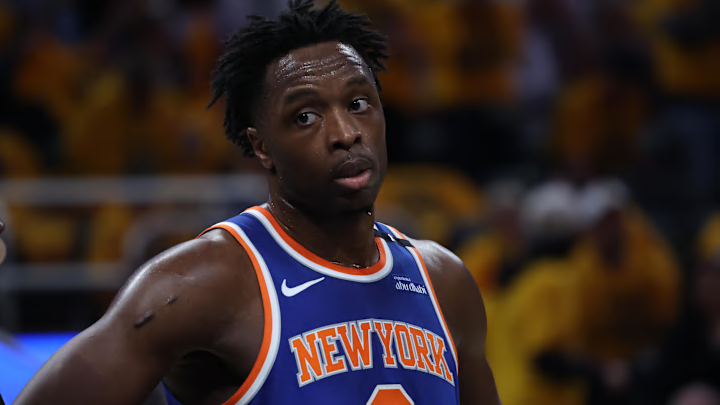As everyone continues to focus on the New York Knicks offense and its proliferation of missed threes-pointers, a somewhat shocking development is falling by the wayside: This team ranks fifth in defensive efficiency.
Opening-stretch samples are littered with noise, and must be presented with the usual “It’s still early” caveats. Even by that standard, though, no one had the Knicks fielding a bottom-10 offense while cracking the top five of points allowed per possession to start the season.
There is a real temptation to dismiss these defensive returns. Just as we should expect the offense to rise as New York adjusts to more ball and body movement and three-point volume, we should also anticipate the defense regressing to a mean that’s more reflective of its personnel.
Except, what if the Knicks are actually built to be better on defense than we thought?
The Knicks defense isn’t getting especially lucky
New York’s defensive returns look like even more of a misnomer when you consider that Mitchell Robinson has yet to play, and that Deuce McBride, its best point-of-attack defender, has missed time due to personal reasons as well.
Scanning opponents’ efficiency from beyond the arc is the first thing you do when noticing a defensive performance that seemingly belies the roster. To that end, the Knicks are allowing nearly 47 percent of enemy shots to come from beyond the arc—the largest share in the league.
Yet, as it turns out, New York isn’t getting super lucky here. Opponents are so far hitting 37 percent of their triples, outside of garbage time. The league average is 35.9 percent.
Nothing stands out when expanding the scope to the general defensive shot profile. Relative to where the Knicks are allowing shots, opponents are expected to have an effective field-goal percentage of 54.7. That is almost exactly what they’ve posted. They clock in at 54.4..
A number of factors are fueling New York’s defensive performance
More than luck, the Knicks’ defense is getting a boon from their rebounding. They are grabbing 81.1 percent of opponent misses—tops in the NBA. Only the Golden State Warriors are better at limiting second-chance opportunities per miss.
Karl-Anthony Towns deserves a lot of credit here for his work on the glass. Mike Brown giving more players agency to bring the ball up the floor also seems to have emboldened glass-crashing efforts on the wings. OG Anunoby and Mikal Bridges are notching what would be career-best defensive rebounding rates.
Speaking of the two Wingstop members, both have ratcheted up their overall execution on the less glamorous-end. Anunoby is a caps-lock MENACE. On the perimeter, near the basket, on the ball, off the ball—it doesn’t matter. If the season ended today, he’s making an All-Defense team.
Bridges is more disruptive than he’s been since his days in Phoenix. And the secret behind his uptick isn’t complicated: Brown is putting McBride at the point of attack, and having both Bridges and Anunoby make plays behind him:
I simply cannot believe how reluctant the Knicks were last season to create a paradigm where they had Deuce McBride, a great defender/screen navigator, at the point of attack AND both Mikal Bridges+OG Anunoby looming as help defenders.pic.twitter.com/mckrTAFQDt
— The Strickland (@TheStrickland) October 25, 2025
This trickle-down effect cannot be overstated. Bridges has always been best suited to this exact role. Getting him more minutes alongside both OG and Deuce also increases the ability to apply pressure at multiple levels, allowing the Knicks to limit cleaner looks at the rim, even when they don’t have a top-tier big man on the backline.
Just 18.2 percent of opponent attempts come at the basket with Anunoby, Bridges, and McBride on the floor. That’s nearly half of the league’s average rim rate of 32.7 percent.
Don’t sleep on the Knicks’ defense
Plenty can and will change between now and the end of the season. It’ll be a genuine shocker if the Knicks maintain a top-five defense all year. And while they may not be getting super lucky, they haven’t been unlucky, either.
No one they’ve played has a top-10 offense to start the year (though Cleveland and Miami come pretty close). Defensive rebounding is a lot easier against smaller frontcourts like those in Boston and Miami. The Knicks can’t hope to tread water on defense if they keep turning over the ball so much on offense, either.
Still, a lot of what New York is doing comes down to gobbling up low-hanging fruit: putting players in the right position, crashing the defensive glass, limiting their fouls, etc. And this is happening as they struggle on offense. They’ll have an easier time setting up their defense when they’re not missing so many threes.
So while nobody should Sharpie in the Knicks for a top-five defense all year, we should also be open to the idea that this team is built to do more on that end than we thought, and that their title chances will improve even further because of it.
